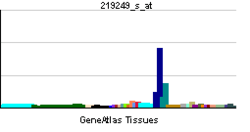FKBP10
| FK506 binding protein 10, 65 kDa | |||||||||||||
|---|---|---|---|---|---|---|---|---|---|---|---|---|---|
| Identifiers | |||||||||||||
| Symbols | FKBP10 ; FKBP65; OI11; OI6; PPIASE; hFKBP65 | ||||||||||||
| External IDs | OMIM: 607063 MGI: 104769 HomoloGene: 7718 GeneCards: FKBP10 Gene | ||||||||||||
| EC number | 5.2.1.8 | ||||||||||||
| |||||||||||||
| RNA expression pattern | |||||||||||||
 | |||||||||||||
| More reference expression data | |||||||||||||
| Orthologs | |||||||||||||
| Species | Human | Mouse | |||||||||||
| Entrez | 60681 | 14230 | |||||||||||
| Ensembl | ENSG00000141756 | ENSMUSG00000001555 | |||||||||||
| UniProt | Q96AY3 | Q61576 | |||||||||||
| RefSeq (mRNA) | NM_021939 | NM_001163481 | |||||||||||
| RefSeq (protein) | NP_068758 | NP_001156953 | |||||||||||
| Location (UCSC) | Chr 17: 39.97 – 39.98 Mb | Chr 11: 100.42 – 100.42 Mb | |||||||||||
| PubMed search | |||||||||||||
FK506-binding protein 10 is a protein that in humans is encoded by the FKBP10 gene.[1][2][3]
The protein encoded by this gene belongs to the FKBP-type peptidyl-prolyl cis/trans isomerase family. It is located in endoplasmic reticulum and acts as molecular chaperones. Two alternatively spliced variants, which encode different isoform, are reported.[3]
References
- ↑ Patterson CE, Schaub T, Coleman EJ, Davis EC (Feb 2001). "Developmental Regulation of FKBP65: An ER-localized Extracellular Matrix Binding-Protein". Mol Biol Cell 11 (11): 3925–35. doi:10.1091/mbc.11.11.3925. PMC 15047. PMID 11071917.
- ↑ Ishikawa Y, Vranka J, Wirz J, Nagata K, Bachinger HP (Nov 2008). "The rough endoplasmic reticulum-resident FK506-binding protein FKBP65 is a molecular chaperone that interacts with collagens". J Biol Chem 283 (46): 31584–90. doi:10.1074/jbc.M802535200. PMID 18786928.
- ↑ 3.0 3.1 "Entrez Gene: FKBP10 FK506 binding protein 10, 65 kDa".
Further reading
- Patterson CE, Gao J, Rooney AP, Davis EC (2002). "Genomic organization of mouse and human 65 kDa FK506-binding protein genes and evolution of the FKBP multigene family". Genomics 79 (6): 881–9. doi:10.1006/geno.2002.6777. PMID 12036304.
- Strausberg RL; Feingold EA; Grouse LH et al. (2003). "Generation and initial analysis of more than 15,000 full-length human and mouse cDNA sequences". Proc. Natl. Acad. Sci. U.S.A. 99 (26): 16899–903. doi:10.1073/pnas.242603899. PMC 139241. PMID 12477932.
- Zhang H, Li XJ, Martin DB, Aebersold R (2003). "Identification and quantification of N-linked glycoproteins using hydrazide chemistry, stable isotope labeling and mass spectrometry". Nat. Biotechnol. 21 (6): 660–6. doi:10.1038/nbt827. PMID 12754519.
- Ota T; Suzuki Y; Nishikawa T et al. (2004). "Complete sequencing and characterization of 21,243 full-length human cDNAs". Nat. Genet. 36 (1): 40–5. doi:10.1038/ng1285. PMID 14702039.
- Gerhard DS; Wagner L; Feingold EA et al. (2004). "The Status, Quality, and Expansion of the NIH Full-Length cDNA Project: The Mammalian Gene Collection (MGC)". Genome Res. 14 (10B): 2121–7. doi:10.1101/gr.2596504. PMC 528928. PMID 15489334.
- Won J; Kim M; Yi YW et al. (2005). "A magnetic nanoprobe technology for detecting molecular interactions in live cells". Science 309 (5731): 121–5. doi:10.1126/science.1112869. PMID 15994554. (Retracted. If this is intentional, please replace
{{Retracted}}with{{Retracted|intentional=yes}}.) - Otsuki T; Ota T; Nishikawa T et al. (2007). "Signal sequence and keyword trap in silico for selection of full-length human cDNAs encoding secretion or membrane proteins from oligo-capped cDNA libraries". DNA Res. 12 (2): 117–26. doi:10.1093/dnares/12.2.117. PMID 16303743.
- Foster LJ; Rudich A; Talior I et al. (2006). "Insulin-dependent interactions of proteins with GLUT4 revealed through stable isotope labeling by amino acids in cell culture (SILAC)". J. Proteome Res. 5 (1): 64–75. doi:10.1021/pr0502626. PMID 16396496.
| |||||||||||||